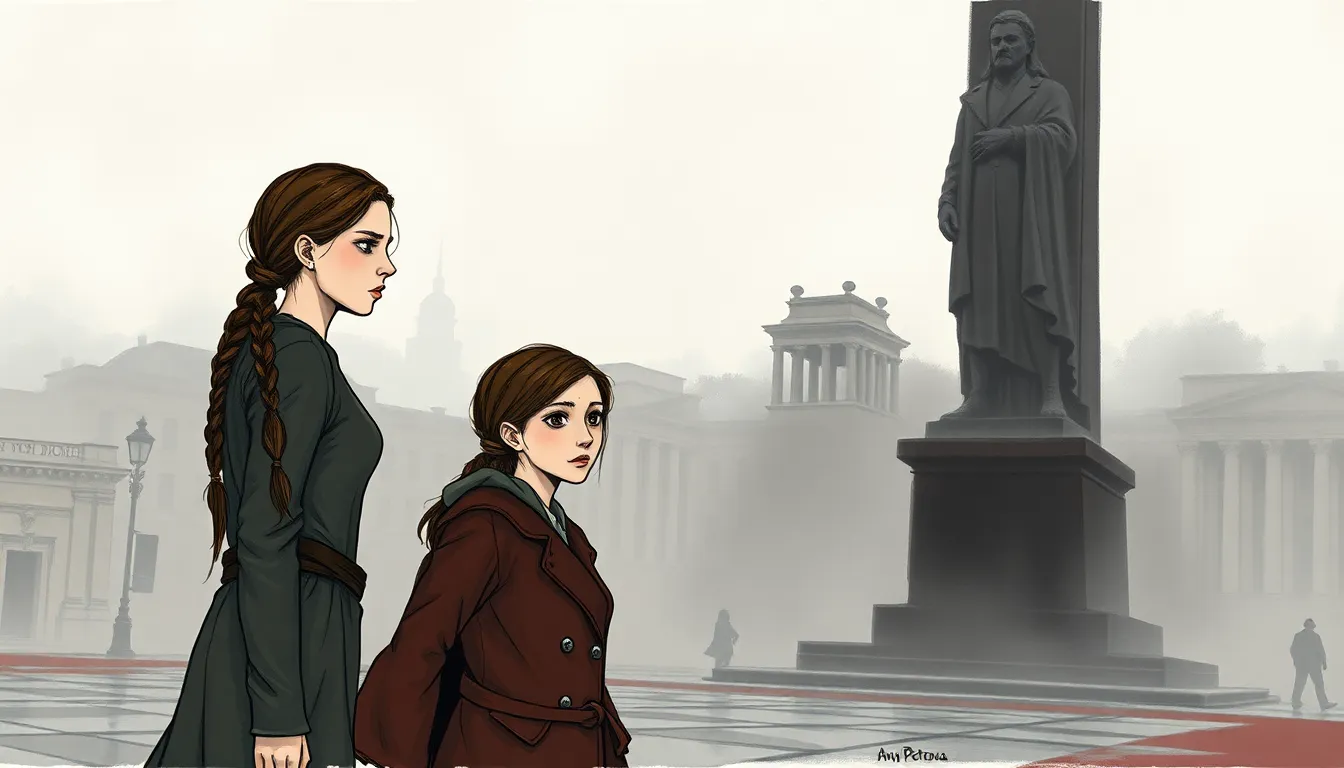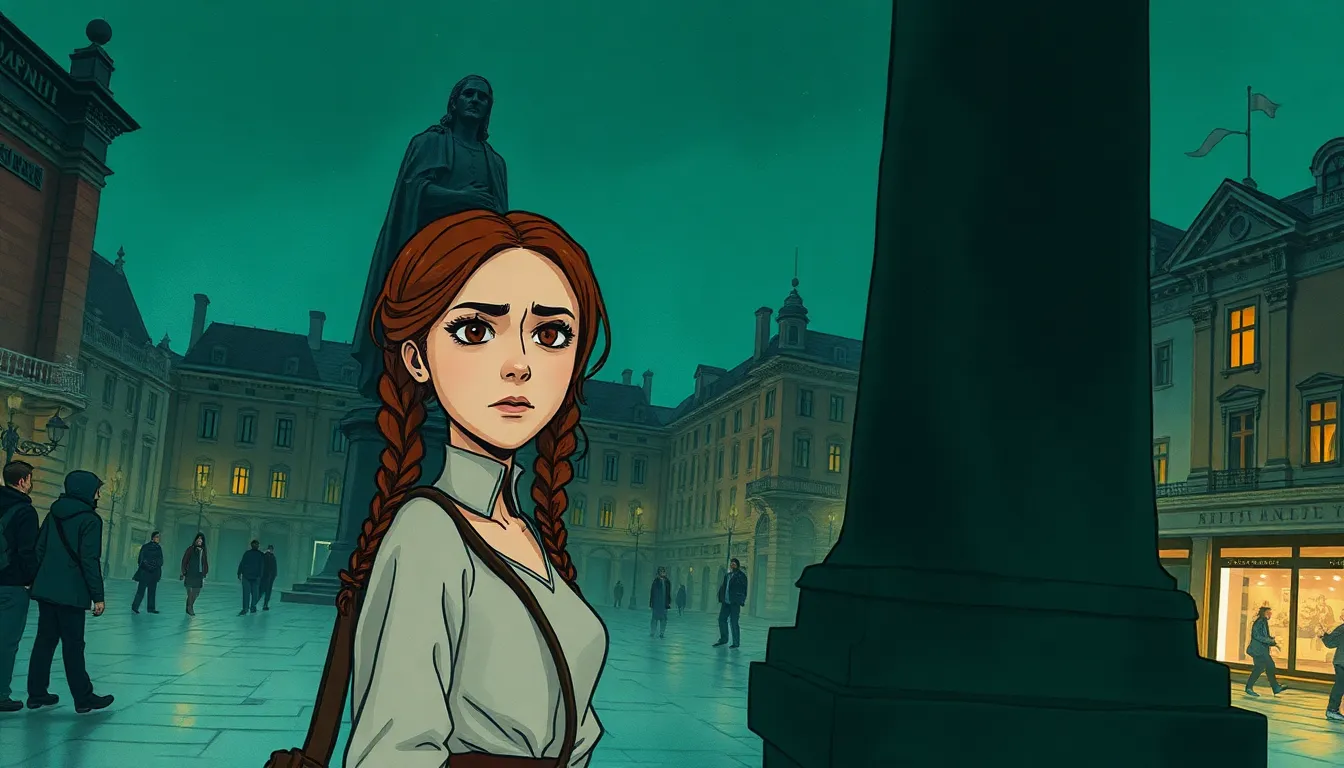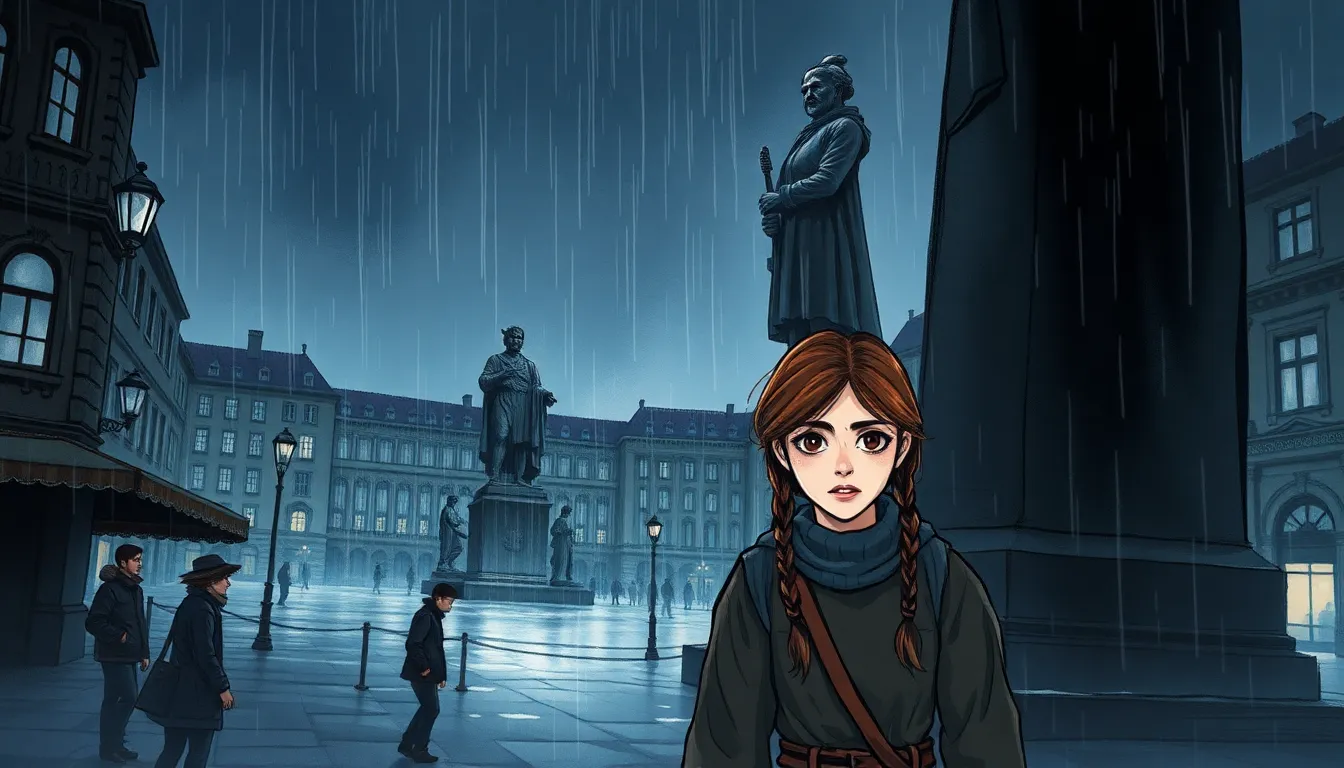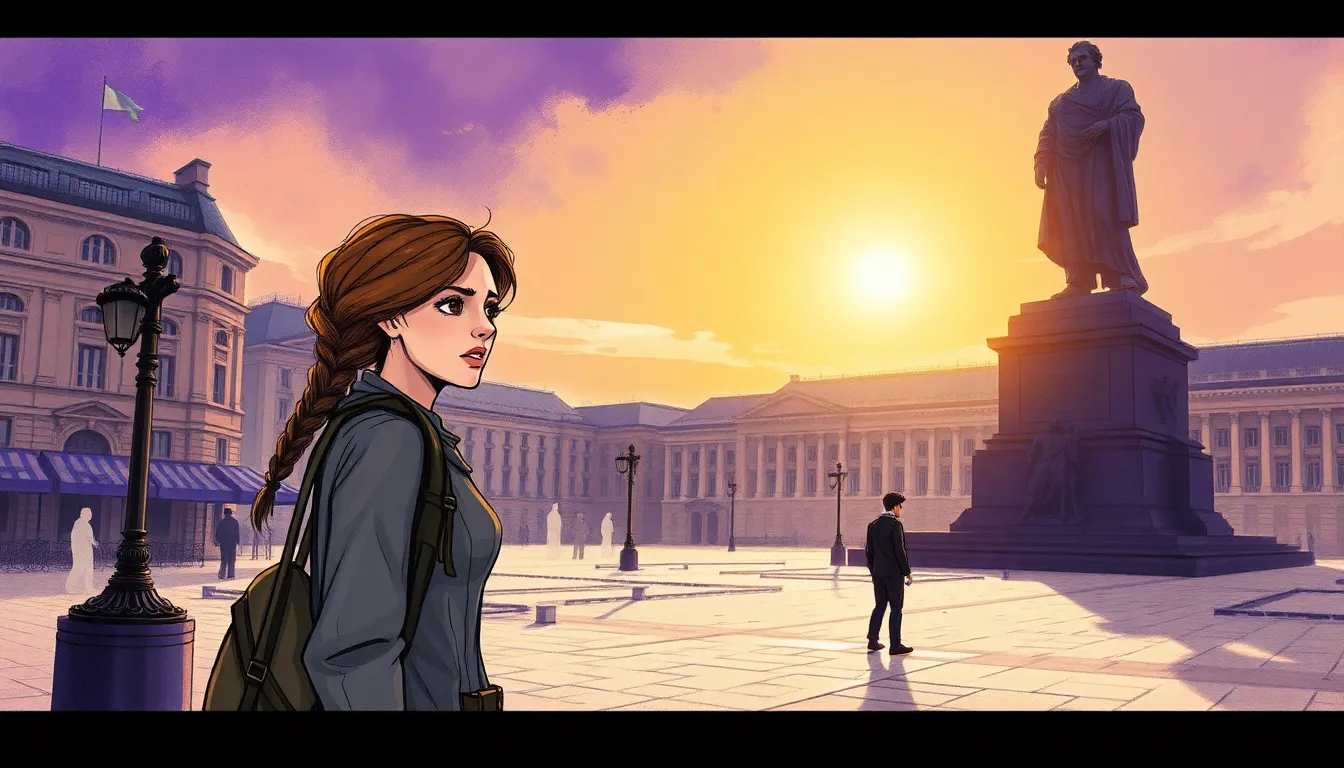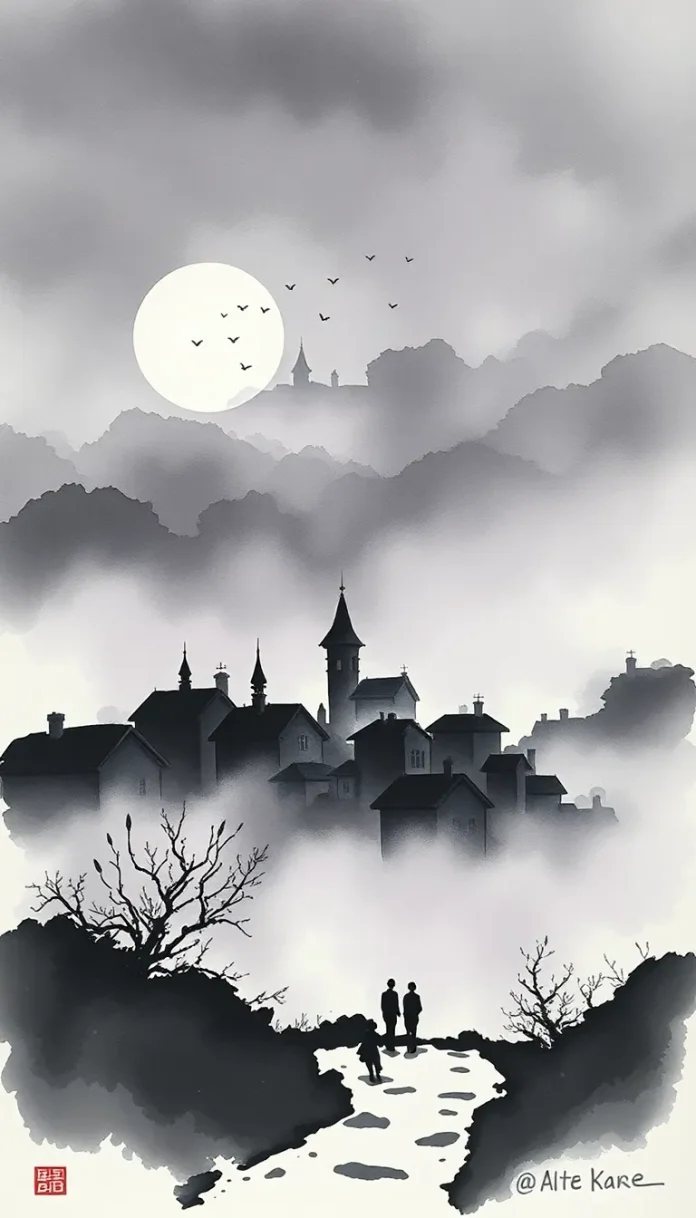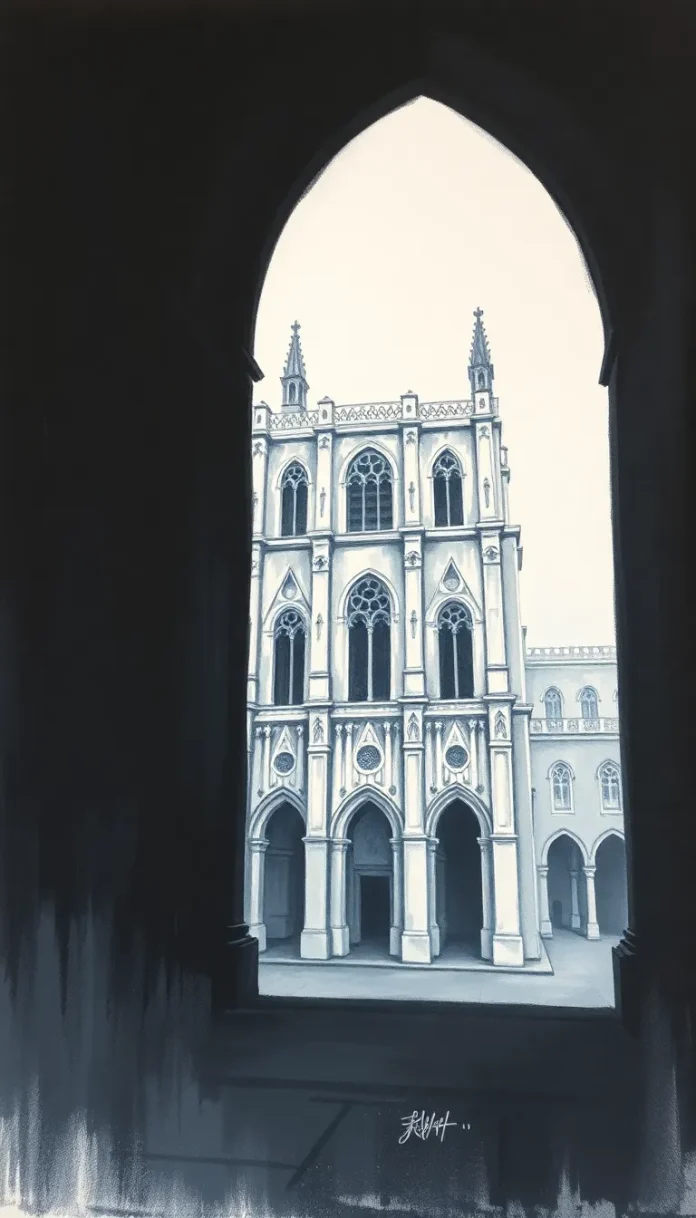The Silent Arrival
The Statue of Silent Judgments emerged on the horizon of the city square as if summoned from an age-old myth. In the dim light of early dusk, the towering edifice of dark stone cast a long, mysterious shadow upon cobblestones worn by the passage of countless souls. The air vibrated with a somnolent hush and the murmur of distant voices as citizens ambled across the square, each absorbed in the ceaseless rhythm of their lives.
Amid this daily procession moved a figure whose presence was at once both fragile and determined. Citizen Anya Petrova, a young woman with skin fair and braided brown hair delicately framing her anxious hazel eyes, clutched onto the quiet familiarity of her simple city attire. As she walked, her gaze repeatedly flitted toward the silent guardian whose impassive face watched from its lofty pedestal. The icon of relentless mood and unspoken judgment, The Statue of Silent Judgment, stood as a mute arbiter of the fortunes and flaws of those who dared to traverse its domain.
On that particular evening, the interplay of light and shadow rendered the scene both somber and hauntingly beautiful. The fading sunlight lent an ambient glow to the square, while the statue’s stone visage appeared to possess a depth of wisdom and severity beyond mortal ken. Anya’s steps slowed and her heart quickened as an inner turmoil blossomed. She wondered if the silent authority of the figure might harbor secrets of morality and fate, secrets that could alter the course of a life already marred by self-doubt.
In hushed tones and half-dreamt thoughts, the citizens began to murmur legends of an unseen force that weighed every deed and whispered fate into the winds. A few recalled moments of inexplicable fortune or misfortune following a mere glance at the statue. The legend had roots deep in social memory, intertwined with the fabric of the city’s soul; each person, however briefly, was both witness and subject to these silent decrees.
As twilight deepened the chiaroscuro of the square, Anya felt an overwhelming urge to understand the origins of this mysterious power. Her inner voice demanded answers yet left her paralyzed by a persistent fear of judgment. Could she dare to pierce the silence of that unmoving sentinel and discover the true nature of its unyielding gaze? Thus, with tentative resolve and a mind burdened by centuries of untold secrets, she stepped nearer, her heart beating in the cadence of both hope and despair.
In an instance of quiet clarity, the square transformed into a silent theatre of both old myth and present angst. The conversation of stones and souls merged into one, leaving behind a questioning spirit and fragile attempts at understanding. As Anya’s footsteps merged with the whispers of history, the silent judgment of the statue loomed large, an ever-present reminder that beneath the veneer of everyday life, there exist forces that are as inscrutable as they are inevitable.
Reflections in Stone
In the heart of the bustling square, the interplay of rumor and despair became a mirror into human nature. Citizens whispered hallowed tales about the statue, conjecturing that its gaze carried the weight of centuries. Amid this symphony of voices, the legends grew with an intensity that rendered every cobblestone alive with memory and mystery. The interplay between the voiceless sentinel and the ever-questioning collective soul stirred emotions steeped in both melancholy and introspection.
Anya found herself drawn to the murmurs of these quiet conspiracies. She lingered at the fringes of conversations and stray gatherings, contemplating the hidden meaning behind the silent figure. In quiet conversations, old men spoke with venerable conviction: tales of fortunes reversed by a mere glance and fates subtly woven by an unseen judgment. Their words, although wrapped in subtle allegory, resonated deeply within her fragile heart.
Late one misty evening, as lamplight softened the city’s edge, Anya settled upon a battered bench near the base of the towering effigy. Her eyes traced the harsh contours of the statue, half obscured by wisps of shadow. The interplay between the chiseled stone and the evening fog transformed the inanimate figure into an embodiment of silent scrutiny. Each rough-hewn line seemed to echo an ancient decree, urging those who dared to dream of upending fate to step into the fray of moral reckoning.
In a hushed inner dialogue, she confided her fears and aspirations. Was the statue a mere relic of indifferent stone or did it bind the community in an unspoken pact of judgment? The mural of her thoughts swirled like ink in water, uncertain and beautiful; the city’s pulse, interwoven with myth and reality, continued unabated. In these moments, the social fabric of the city was revealed as a reflection of souls haunted by the omnipresent force of judgment.
Anya recalled a conversation with an elderly neighbor who once confided, “In the quiet of the night, listen to the whispers of stone and heart alike ”. Such words, full of subtext and longing, lent her courage even as they deepened her uncertainty. The statue, half-enlightener and half-censor, had become a symbol for the burdens carried silently by every citizen who dared question their worth.
As the hours waned and darkness embraced the square, Anya resolved to venture further into the shadows of her own thoughts and of the city. The interplay of natural beauty, myth, and human frailty inspired her to imprint her will upon the unsaid. Yet, all the while, the silent judgment of the ageless monument remained, casting its immutable shadow upon the dreams of the inhabitants.
The Burden of Inquiry
A heavy fog of introspection had settled upon the square and within the hearts of those who trod its ancient stones. Night after night, under the silver gleam of the moon, Anya found herself haunted not only by the enigmatic visage of the towering statue but by a deeper questioning of her own conscience. Like a recurring dream, the silent observations of that monumental figure urged her to confront the intricate tapestry of her inner life.
During a particularly restless evening, as a cool breeze danced with the falling leaves, Anya wandered along the square’s narrow pathways, each step resonating with the cadence of her inner dilemma. She questioned the silent criteria by which the statue seemed to measure every soul, scouring her own life for sins and virtues in a desperate quest for absolution. The city around her, alive with murmurs of forgotten truths, transformed into a stage upon which her own morality would be theatrically recast.
The darkness invited dialogue with herself and with the unseen powers that governed the fate of the many. Amid her self-doubt, a memory surfaced of a gentle whisper from her childhood, a voice that spoke of a universe where every act, however small, bore significance. Yet the cold, unyielding stone before her was a stern reminder that life’s judgments were rarely merciful. The weight of that realization threatened to engulf her, leaving behind a trace of solemn resignation that seemed to haunt every fleeting sigh of the night.
In an almost whispered soliloquy, she murmured, “Am I not equally bound by the unseen standards of honor and regret?” Her words, lost amidst the rustling of the night air, were an earnest plea for an answer that could reconcile her inner doubts. This conversation with herself, silent yet fervent, was mirrored by the immutable silence of the statue, whose impassive gaze remained a constant reminder of human frailty under the scrutiny of fate.
The invisible weight of society s norms, intertwined with personal guilt and longing, built an elusive bridge between the spontaneous beauty of human imperfection and the rigid decree of an ancient monument. In that reflective solitude, Anya began to comprehend that the burden of inquiry was not one imposed solely by an external force but was, rather, a cumulative legacy of intergenerational whispers and silent expectations. Each citizen was at once victim and executor of this unending judgment, and to navigate it meant to embrace the paradox of our own existence.
Thus, the square, cold and inscrutable, became a forum for silent debates. Every stone, every whisper of wind, seemed to echo the eternal question: how does one balance the scales of internal redemption against the immutable verdicts of a bygone era? In this crucible of deep thought, the essence of the human spirit was gradually laid bare, and Anya s internal struggle became emblematic of the broader human quest for meaning and self-worth.
The Shadows of Doubt
As autumn settled into the fabric of the city, a palpable tension began to weave itself into the everyday lives of its inhabitants. The square, which had once been merely a thoroughfare of human existence, had transformed into a crucible of introspection and travail. The omnipresent figure of the stone behemoth loomed over all, its silent vigil fostering both a latent fear and a strange form of comfort. In its immobility, it offered a mirror to the inner workings of hearts laden with both hope and despair.
Anya, now more deeply entangled in the mystery than ever before, traversed the square with a mind heavy and turbulent. Shadows lengthened across the stone and pavements, drawing outlines of murmuring figures and fleeting specters of the past. Every step was accompanied by the echo of internal doubts and the burden of unseen judgment. Her nervous glances toward the statue were no longer mere expressions of apprehension but had grown into a ritual of seeking reassurance in the face of uncertainty.
In hushed encounters with fellow citizens on rain-slicked sidewalks, voices trembled with tales of missed opportunities and inexplicable strokes of fate. One such encounter found Anya in conversation with a weary street vendor, his eyes reflecting years of accumulated regrets. He confided in a tone more resigned than mournful, “This stone watches over us all, weighing our deeds in scales unseen, reminding us that every shadow hides both sin and salvation.” His words, delivered as a soft incantation, resonated with the despair of those who dared to challenge society s unspoken mandates.
The syndrome of doubt had taken root in every crevice of her soul. It was as if the entire square was layered with a spectral miasma, a tangible expression of internal conflict. Each whispered confession of a secret transgression, each furtive hope for redemption, was met by that cold and impassive stare. Anya began to perceive the square as a canvas where every human frailty was meticulously recorded, each soul’s quiet fear shelved alongside its secret dreams.
Yet within this chiaroscuro of light and darkness, a subtle transformation was underway. In the intersection of anxiety and resolution, the dense shadows began to recede, coaxing forth the possibility of acceptance. Anya, amidst the sprawling tapestry of human emotion, realized that the true burden was not the silent judgment itself but the internalized echo of every learned doubt. The interplay between self-criticism and the unyielding gaze of the monument fostered the potential for understanding: that the silent arbiter was but a reflection of society s unresolved conflicts and the eternal quest for meaning.
Thus, as night deepened and the confounding silhouettes blended with the murmuring winds, the square offered a lesson in the duality of human nature: that even in the engulfing shadows of doubt, a quiet hope could take root, inviting each soul to confront its internal darkness and emerge, if only slightly, into the light of self acceptance.
The Awakening of Fortunes
In the final light of a somber day, as dawn crept slowly over the horizon, there came a quiet revolution in the city square of judgment. The relentless gaze of the stone sentinel, once a harbinger of inscrutable decrees and paralyzing fear, gradually revealed itself to embody both the weight and liberation of fate. Anya, her heart now etched with the lessons of long nights and introspective wanderings, recognized that the silence that had so long haunted her was not solely a burden, but also a canvas upon which new fortunes could be written.
The transformation was subtle and profound, permeating every chatter in the marketplace and every muted interaction between friends and strangers alike. Under the gentle caress of an awakening sun, the square exuded an atmosphere of tentative hope. The once oppressive judgment of the statue was reinterpreted as a reminder that within every individual lay the power to redefine destiny and to question the very standards by which life was measured.
On a brisk morning, Anya found herself standing once more before the silent monument. No longer did fear clutch at her spirit; instead, a calm resolve filled her eyes. She recalled every whispered legend, every moment of introspection and despair, and understood that the statue was both a relic of social expectation and a mirror reflecting her own growth. In this singular moment of clarity, the boundaries between external judgment and internal conscience blurred, merging into a harmonious call for self redemption.
In a voice both tender and resolved, she murmured softly to herself, “If our hearts can question the edicts of stone, then perhaps the weight of judgment can be lessened by the light of our own truth.” These words, carried away by the morning breeze, seemed to dissolve the barriers of age-old lore, transforming the square into a sanctuary of honest reflection and communal rebirth.
The awakening was not an instant vanishing of all woes but a gradual acceptance that judgment need not be a tool of oppression. Rather, it could be a catalyst for growth, urging every soul to examine its actions and strive towards a higher understanding of morality, compassion, and self worth. The citizens, once ensnared in the invisible web of silent decrees, began to see themselves as the architects of their own fortunes. Each step taken away from the paralyzing weight of fear was a step toward reclaiming the human spirit in all its flawed magnificence.
Thus, as the sun rose higher and bathed the square in gentle radiance, a new day began. The stone guardian, still imposing and enigmatic, bore witness to the transformation as it continued its eternal watch. In that balanced interplay between judgment and hope, the city found solace and the promise of renewal. The awakening of fortunes had arrived, tender yet resolute, and with it, the invitation for every soul to forge a future free from the chains of silent judgment.

